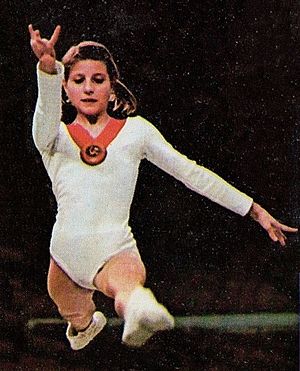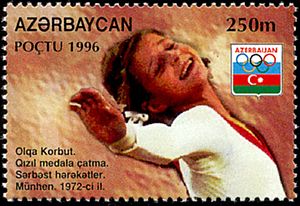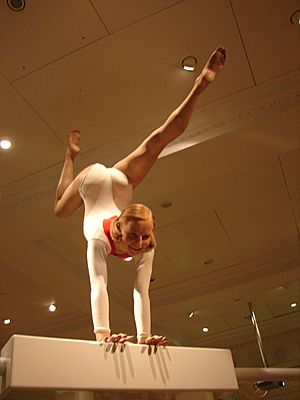Olga Korbut facts for kids
Quick facts for kids Olga Korbut |
|||||||||||||||||||||||||||||||||||||||||||||||||||||
|---|---|---|---|---|---|---|---|---|---|---|---|---|---|---|---|---|---|---|---|---|---|---|---|---|---|---|---|---|---|---|---|---|---|---|---|---|---|---|---|---|---|---|---|---|---|---|---|---|---|---|---|---|---|

Olga Korbut c. 1972
|
|||||||||||||||||||||||||||||||||||||||||||||||||||||
| Personal information | |||||||||||||||||||||||||||||||||||||||||||||||||||||
| Full name | Olga Valentinovna Korbut | ||||||||||||||||||||||||||||||||||||||||||||||||||||
| Nickname(s) | Sparrow from Minsk | ||||||||||||||||||||||||||||||||||||||||||||||||||||
| Country represented | |||||||||||||||||||||||||||||||||||||||||||||||||||||
| Born | 16 May 1955 Hrodna, Belarusian SSR, Soviet Union (USSR) |
||||||||||||||||||||||||||||||||||||||||||||||||||||
| Discipline | Women's artistic gymnastics | ||||||||||||||||||||||||||||||||||||||||||||||||||||
| Club | Soviet Army Grodno | ||||||||||||||||||||||||||||||||||||||||||||||||||||
| Head coach(es) | Renald Knysh | ||||||||||||||||||||||||||||||||||||||||||||||||||||
| Eponymous skills | Korbut flip | ||||||||||||||||||||||||||||||||||||||||||||||||||||
| Retired | 1977 | ||||||||||||||||||||||||||||||||||||||||||||||||||||
|
Medal record
|
|||||||||||||||||||||||||||||||||||||||||||||||||||||
Olga Valentinovna Korbut (born 16 May 1955) is a famous retired gymnast from Belarus. She competed for the Soviet Union and was known as the "Sparrow from Minsk".
Olga won four gold medals and two silver medals at the Summer Olympic Games. She competed in the Olympics in 1972 and 1976. In 1988, she was the very first gymnast to be added to the International Gymnastics Hall of Fame.
Olga Korbut stopped competing in gymnastics in 1977 when she was 22. This was considered young for gymnasts back then. However, her impact on the sport was huge. Many people say her performances at the 1972 Olympics completely changed gymnastics. The sport used to focus more on ballet and grace. After Olga, it became more about amazing acrobatic moves. She also helped make gymnastics one of the most popular sports in the world.
In 1991, Olga moved to the United States. She now lives there and helps train new gymnasts. She became a U.S. citizen in 2000.
Contents
Olga's Early Life and Training
Olga Korbut was born in Grodno, a city in Belarus. She started training in gymnastics when she was 8 years old. At age 9, she joined a special sports school in Belarus. Her coach there was Renald Knysh.
Olga's first trainer was Elena Volchetskaya, who won an Olympic gold medal in 1964. But after a year, Olga moved to Knysh's group. He noticed her amazing talent and how flexible her back was. With him, she learned a very difficult backward somersault on the balance beam. She showed this move for the first time in a competition in the USSR in 1969.
In the same year, Olga also did a backflip-to-catch on the uneven bars. This was the first time a woman had ever done a backward release move on the bars.
At her first competition, the 1969 USSR championships, she finished fifth. She was only 14 years old. The next year, she won a gold medal in the vault. Before the 1972 Summer Olympics, she couldn't compete much because of illness and injuries.
Olympic Games Highlights

At the 1972 Summer Olympics in Munich, Olga Korbut became very famous. Her acrobatic skills and high-level gymnastics amazed everyone. She was a favorite to win the all-around medal after her strong performance in the team event. However, she made mistakes on the uneven bars, and her teammate Ludmilla Tourischeva won the title.
Even so, Olga won three gold medals! She earned gold for the balance beam, floor exercise, and the team competitions. She also won a silver medal in the uneven bars. Her score on the uneven bars was very controversial. After her first try, she made several mistakes. The next day, she did the same routine perfectly. But when the judges gave her a low score, the audience was very upset and protested for several minutes. The judges did not change the score.
Olga Korbut was best known for her exciting routines on the uneven bars and balance beam. Her performances truly captured the audience's attention. In 1973, she won competitions in Russia and at the World Student Games. She also won a silver medal in the all-around at the European Championships.
At the 1976 Summer Olympics in Montreal, Olga was expected to challenge Nadia Comăneci, a young star from Romania. However, Olga was injured, and her performances were not as strong. She was outshone by both Comăneci and her own teammate, Nellie Kim. Still, she won a team gold medal and an individual silver medal for the balance beam.
Life After Gymnastics
Olga Korbut finished her studies at the Grodno Pedagogical Institute in 1977. She became a teacher and stopped competing in gymnastics. She married Leonid Bortkevich, who was a member of a Belarusian folk band called Pesniary. They had a son named Richard in 1979. In 1988, Olga became the first gymnast ever to be inducted into the International Gymnastics Hall of Fame.
In 1991, Olga and her family moved to the United States. They were worried about the effects of the Chernobyl disaster on Belarus. They first settled in New Jersey, where Olga taught gymnastics. Two years later, they moved to Georgia, and she continued coaching there. Olga and Leonid divorced in 2000. In the same year, she became a U.S. citizen.
In 2002, she moved to Scottsdale, Arizona. There, she became the head coach at Scottsdale Gymnastics and Cheerleading. Olga also appeared on an episode of Celebrity Boxing on May 22, 2002. Since then, she has worked with private gymnastics students and given motivational speeches.
During the 2012 Summer Olympics in London, Olga Korbut shared her thoughts on the gymnastics competitions live on Twitter and Facebook. The Royal Opera House also held an exhibition called The Olympic Journey, The Story of the Games. This show featured stories from 16 Olympic medalists, including Olga. Her visit to the exhibition on August 3, 2012, marked 40 years since her Olympic victories. She said she was very honored to be there.
In 2017, Olga sold her Olympic medals from 1972 and 1976. These, along with other items, were sold at an auction for $333,500.
In 2021, the Carnegie Corporation of New York honored Olga Korbut with the Great Immigrants Award.
Olga Korbut's Gymnastics Legacy

Olga Korbut won four Olympic gold medals. She is most famous for a move called the Korbut flip. This is a backflip done on the uneven parallel bars. She would stand on the high bar, do a backflip, and then catch the same bar from below. She also did a similar flip on the balance beam, landing in a straddle position or on her feet. The move is named after her because she was the first to perform it in an international competition in 1972. However, the uneven bars version of the Korbut flip is now not allowed in Olympic competitions.
After the 1972 Olympics, Olga met United States President Richard Nixon at the White House. Olga said that President Nixon told her her performance in Munich did more to reduce political tension between their countries during the Cold War than embassies had done in five years.
Olga's performances made gymnastics much more popular around the world. She also changed the sport itself. Before 1972, gymnasts were usually older, and the focus was on elegance. After Olga's Olympic debut, the sport started to focus more on acrobatics. Olga, who was 4 feet 11 inches tall and weighed 82 pounds in 1972, showed a new trend towards smaller gymnasts in the sport.
Her success at the 1972 Olympics earned her the BBC Sports Personality World Sport Star of the Year award. She was also named Athlete of the Year by ABC's Wide World of Sports. In a UK poll in 2002, the public voted "Olga Korbut charms the world" as No. 46 in the list of the 100 Greatest Sporting Moments.
Olga Korbut, along with Nadia Comăneci, brought huge popularity to gymnastics in the 1970s. Their artistic and graceful performances are now seen as a special part of gymnastics history, even as athleticism has become more important.
Special Gymnastics Moves Named After Olga
Olga Korbut has one vault move officially named after her in the Code of Points. She also performed the Korbut flip on both the uneven bars and the balance beam. The uneven bars version was removed from the Code of Points because standing on top of the high bar is no longer allowed. The balance beam version is not officially listed under her name because it is considered a low-difficulty move now.
| Apparatus | Name | Description | Difficulty |
|---|---|---|---|
| Vault | Korbut | Handspring forward with a full turn (360°) on – full turn (360°) off | 3.6 |
Olga in Pop Culture
- In a Peanuts comic strip from May 15, 1973, the character Snoopy is shown doing perfect balance beam poses on his doghouse. In the last panel, he says, "Olga Korbut has been bugging me for lessons!"
- In X-Men #99 (June 1976), the character Nightcrawler mentions Olga Korbut's gymnastics skills. Colossus, who is also from the Soviet Union, tells him off for it.
Olga's Competitive History
| Year | Event | Team | AA | VT | UB | BB | FX |
|---|---|---|---|---|---|---|---|
| Junior Competitions | |||||||
| 1967 | Junior USSR Championships | ||||||
| Senior Competitions | |||||||
| 1969 | Junior Friendship Tournament | 4 | |||||
| USSR Championships | 5 | ||||||
| 1970 | Chunichi Cup | ||||||
| Junior Friendship Tournament | 4 | ||||||
| Tokyo Cup | |||||||
| USSR Championships | 15 | ||||||
| 1971 | Chunichi Cup | ||||||
| GDR-USSR Dual Meet | |||||||
| JPN-USSR Dual Meet | |||||||
| USSR Championships | 4 | ||||||
| 1972 | Riga International | ||||||
| USSR-FRG-CAN Tri-Meet | |||||||
| USSR-TCH Dual Meet | |||||||
| USSR Championships | 7 | ||||||
| USSR Cup | |||||||
| Olympic Games | 7 | 5 | |||||
| 1973 | |||||||
| European Championships | |||||||
| Summer Universiade | |||||||
| 1974 | USSR Championships | ||||||
| USSR Cup | 4 | ||||||
| World Championships | |||||||
| 1975 | USSR Championships | 6 | 6 | ||||
| USSR Spartikade | |||||||
| 1976 | Cup of the White Russian Republic | ||||||
| USSR Cup | |||||||
| Olympic Games | 5 | 5 | |||||
See also
 In Spanish: Olga Kórbut para niños
In Spanish: Olga Kórbut para niños
- List of people from Belarus
- List of multiple Olympic gold medalists at a single Games
- List of top Olympic gymnastics medalists
- List of Olympic female gymnasts for the Soviet Union
External links
- Olga Korbut at the International Gymnastics FederationLua error in Module:EditAtWikidata at line 29: attempt to index field 'wikibase' (a nil value).
- Olga Korbut at the International Gymnastics Hall of FameLua error in Module:EditAtWikidata at line 29: attempt to index field 'wikibase' (a nil value).
- Olga Korbut at Olympics.com (archived: OlympicChannel.com and Olympic.org)Lua error in Module:EditAtWikidata at line 29: attempt to index field 'wikibase' (a nil value).
- Olga Korbut at OlympediaLua error in Module:EditAtWikidata at line 29: attempt to index field 'wikibase' (a nil value).
- Olga Korbut at the National Olympic Committee of the Republic of Belarus
- Incredible Performance From Olga Korbut 'Darling Of Munich' – Munich 1972 Olympics – The Olympic Channel
- Gymnast Olga Korbut charms the World – Faster, Higher, Stronger – BBC Two – BBC

